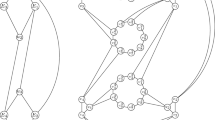Abstract
A subsetA of the edge set of a graphG = (V, E) is called a clique partitioning ofG is there is a partition of the node setV into disjoint setsW 1,⋯,W k such that eachW i induces a clique, i.e., a complete (but not necessarily maximal) subgraph ofG, and such thatA = ∪ k i=1 1{uv|u, v ∈ W i ,u ≠ v}. Given weightsw e∈ℝ for alle ∈ E, the clique partitioning problem is to find a clique partitioningA ofG such that ∑ e∈A w e is as small as possible. This problem—known to be
-hard, see Wakabayashi (1986)—comes up, for instance, in data analysis, and here, the underlying graphG is typically a complete graph. In this paper we study the clique partitioning polytope
of the complete graphK n , i.e.,
is the convex hull of the incidence vectors of the clique partitionings ofK n . We show that triangles, 2-chorded odd cycles, 2-chorded even wheels and other subgraphs ofK n induce facets of
. The theoretical results described here have been used to design an (empirically) efficient cutting plane algorithm with which large (real-world) instances of the clique partitioning problem could be solved. These computational results can be found in Grötschel and Wakabayashi (1989).
Similar content being viewed by others
References
J.P. Barthélemy and B. Monjardet, “The median procedure in cluster analysis and social choice theory,”Mathematical Social Sciences 1 (1981) 235–267.
J.A. Bondy and U.S.R. Murty,Graph Theory with Applications (Macmillan, London, 1976).
M. Grötschel and Y. Wakabayashi, “A cutting plane algorithm for a clustering problem,”Mathematical Programming (Series B) 45 (1989) 59–96.
R.M. Karp and C.H. Papadimitriou, “On linear characterizations of combinatorial optimization problems,”SIAM Journal on Computing 11 (1982) 620–632.
J.F. Marcotorchino and P. Michaud, “Optimization in exploratory data analysis,”Proceedings of 5th International Symposium on Operations Research (Physica Verlag, Köln, 1981).
J.F. Marcotorchino and P. Michaud, “Heuristic approach to the similarity aggregation problem,”Methods of Operations Research 43 (1981) 395–404.
S. Régnier, “Sur quelques aspects mathématiques des problèmes de classification automatique,”International Computer Centre Bulletin (1965).
M. Schader and U. Tüshaus, “Ein Subgradientenverfahren zur Klassification qualitativer Daten,”Operations Research Spektrum 7 (1985) 1–5.
A. Schrijver,Theory of Linear and Integer Programming (Wiley, Chichester, 1986).
U. Tüshaus, “Aggregation binärer Relationen in der qualitativen Datenanalyse,” in:Mathematical Systems in Economics, Vol. 82 (Hain, Königstein, 1983).
Y. Wakabayashi, “Aggregation of binary relations: algorithmic and polyhedral investigations,” Ph.D. Thesis, Universität Augsburg (Augsburg, 1986).
Author information
Authors and Affiliations
Rights and permissions
About this article
Cite this article
Grötschel, M., Wakabayashi, Y. Facets of the clique partitioning polytope. Mathematical Programming 47, 367–387 (1990). https://doi.org/10.1007/BF01580870
Received:
Revised:
Issue Date:
DOI: https://doi.org/10.1007/BF01580870




